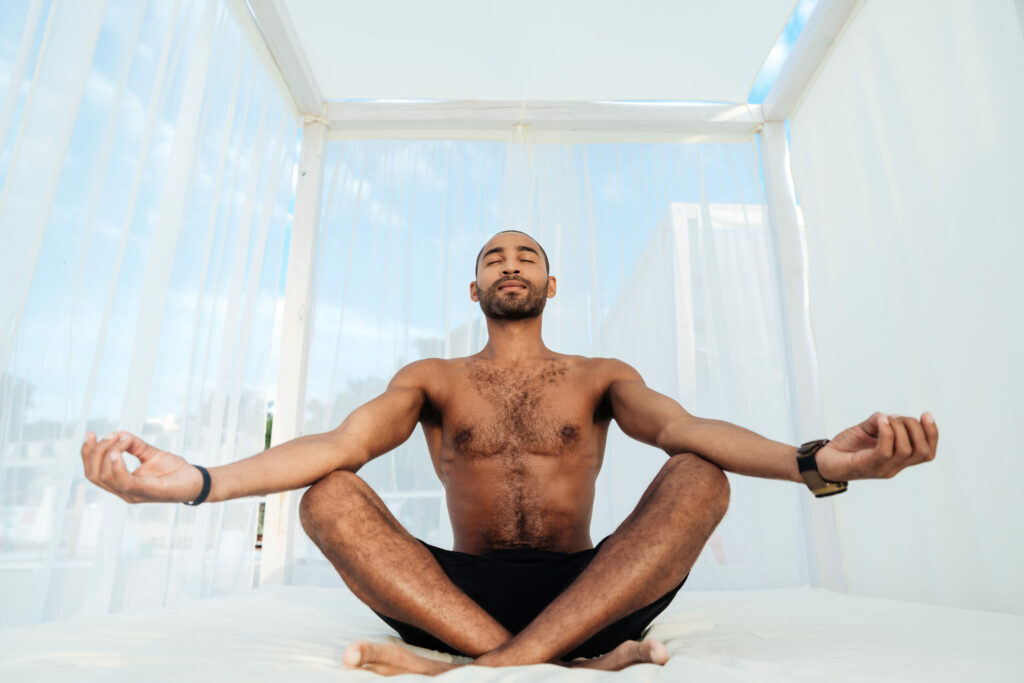Stress, an inevitable aspect of modern life, impacts us all. However, the way we manage stress can significantly influence our health, happiness, and overall quality of life. In this extended guide, we’ll explore the four key methods to master stress, incorporating principles from “The Clear Solution’s Balance Baseline Guidebook.” These methods will provide you with practical steps to implement in your daily life for a more balanced and peaceful existence.
Understanding Stress
Stress is your body’s natural response to challenges or demands. It can stem from both positive and negative experiences and is a part of our survival mechanism. However, chronic stress can lead to a range of health issues, both mental and physical. Understanding the nature of stress and its sources in your life is the first step towards mastering it.

The Four Key Methods to Master Stress
Method #1: Prioritizing Health and Wellness.
This means making a conscious effort every day to care for your physical and mental well-being.
Activities like yoga can improve flexibility and reduce anxiety. Yoga is an incredible tool for both physical and mental well-being. Yoga combines physical postures with breathing techniques and meditation, offering a holistic approach to stress management. It helps in releasing tension, enhancing mindfulness, and bringing a sense of balance to your life. Whether you’re a beginner or a seasoned practitioner, yoga can be adapted to suit your needs and help you manage stress more effectively.
In addition to yoga, meditation can also bring clarity and calmness to your mind. This ancient practice offers a myriad of benefits, from reducing stress to increasing self-awareness. Meditation can be as simple as focusing on your breath, or as deep as engaging in guided visualization.
The key is consistency.
Even a few minutes each day can lead to greater emotional resilience and a more peaceful state of mind. If you’re new to meditation, start small and explore different methods to find what works best for you. It’s about finding what nurtures your soul and making it a non-negotiable part of your daily routine.

Movement and meditation are only the beginning to prioritizing your health and wellness. Let’s break this down even further:
Mindful Awareness
Mindfulness, the practice of being present and fully engaged with whatever we’re doing at the moment, is a powerful antidote to stress. It allows us to step back from our thoughts and start observing them rather than getting caught up in them.
Practical Tips:
- Start with a simple meditation routine, even just five minutes a day can make a difference.
- Practice deep breathing exercises to center your mind.
- Engage in daily activities mindfully, like eating or walking.

Movement Medicine
Exercise is a proven stress reliever. It not only improves your physical health but also boosts your mood and serves as a valuable outlet for frustrations.
Practical Tips:
- Incorporate different types of exercise into your routine: cardiovascular for endurance, strength training for resilience, and yoga for flexibility and mental calm.
- Find an activity you enjoy – if you love what you do, you’ll be more likely to stick with it.

Balanced Nutrition
Nutrition plays a critical role in how we feel and respond to stress. Eating a balanced diet can help stabilize your mood, improve your energy levels, and reduce the physical impact of stress on your body.
Practical Tips:
- Include a variety of fruits and vegetables in your diet.
- Limit intake of caffeine and sugar, which can exacerbate stress.
- Stay hydrated and avoid alcohol and other depressants.

Adequate Sleep
Quality sleep is essential for coping with stress. Lack of sleep can amplify the brain’s anticipatory reactions, contributing to increased stress.
Practical Tips:
- Establish a regular sleep schedule.
- Create a bedtime routine to signal to your body it’s time to wind down.
- Make your bedroom a sanctuary for sleep: cool, dark, and quiet.

Method #2: Gratitude Practice
Gratitude practice is much more than a simple expression of thanks; it’s a transformative approach that reshapes your entire perspective towards life. This practice involves consciously recognizing and appreciating the positive aspects of your life, both big and small. It’s about acknowledging the beauty in the mundane and the extraordinary, fostering a deeper appreciation for the world around you.
Begin and end each day with a moment of reflection on what you’re grateful for. In the morning, this can set a positive tone for your day, helping you start with an optimistic and appreciative mindset. Consider the seemingly small joys – the warmth of the sun on your skin, the comforting aroma of a freshly brewed cup of coffee, or the soothing sound of birds chirping outside your window. These moments, though brief, have the power to uplift your spirits and offer a sense of calm.

In the evening, reflect on the events of the day. Focus on the people who have supported you, the progress you’ve made towards your goals, or the peaceful moments you experienced. Gratitude for significant life aspects like the unwavering support of a loved one, the security of your home, or the satisfaction of a job well done can deeply enhance your sense of well-being.
This gratitude practice isn’t just about creating a list of positive things; it’s about genuinely feeling and embracing the sensation of gratitude. It’s about allowing this feeling to permeate your thoughts and affect how you view challenges and setbacks. By shifting your focus from what you lack to what you abundantly possess, you can dramatically reduce feelings of stress and anxiety. Over time, this practice can lead to a more joyful, peaceful, and fulfilling life, as you learn to appreciate the richness of your everyday experiences.
Method #3: Embrace Silence
In our modern, hyper-connected society, where the buzz of technology and the hustle of daily life are ever-present, finding moments of true silence can be exceptionally rare – and all the more valuable. Embracing silence is not merely about escaping noise; it’s about gifting yourself a sanctuary of stillness in a world that rarely stops moving. This practice of seeking out and soaking in silence is an act of self-care that can bring profound benefits to your mental and emotional well-being.
To begin this journey, seek a tranquil space where the cacophony of daily life cannot reach you. This could be a quiet corner of your home, a peaceful spot in a park, or even a serene location you visit mentally through visualization. The key is to find a place where external distractions are minimized, allowing you to connect deeply with the essence of stillness.
Once in this space of quietude, allow yourself to just exist. This is not a time for doing, but for being. Focus on the rhythm of your breath – the gentle inhale and exhale that anchors you to the present moment. As you breathe, observe your thoughts as they come and go, like leaves floating on a stream. There’s no need to engage with them or judge them; simply let them pass, bringing your attention back to your breath each time.

In these moments of silence, you may find that your mind begins to unwind and declutter, making room for a sense of profound peace and clarity. The constant internal chatter that often accompanies stress and anxiety can slowly quiet down, replaced by a tranquil inner stillness. This practice can significantly enhance your ability to focus, as the mind, freed from the constant barrage of stimuli, learns to become more attentive and aware.
Additionally, regularly dedicating time to silence can lead to deeper levels of inner peace. It’s in these quiet moments that we often find ourselves reconnecting with our inner selves, gaining insights and perspectives that are drowned out in the noise of everyday life. This form of silent introspection can be rejuvenating, offering a sense of renewal and mental clarity.
In summary, embracing silence is much more than a mere absence of noise; it’s an active and mindful practice of seeking stillness amidst life’s chaos. By regularly dedicating time to this practice, you can unlock a host of benefits – from enhanced focus and mental clarity to a profound sense of inner peace and rejuvenation. This method stands as a powerful tool in the journey towards reducing stress and enhancing overall well-being.
Method #4: Journaling
Journaling stands as a potent tool in the realm of self-discovery and stress management. In our busy lives, where thoughts and emotions often swirl chaotically, the act of writing in a journal serves as a haven of reflection and clarity. By translating your inner experiences onto paper, you create a tangible record of your personal journey, offering invaluable insights into your emotional world.
This practice of journaling transcends mere record-keeping; it is a profound form of self-expression. As you write, you unpack layers of emotions, thoughts, and reactions that may have been obscured in the hustle of daily life. This process can reveal underlying patterns in your thoughts and behaviors, illuminating paths to personal growth and self-awareness.
Journaling can also serve as a versatile companion on your life journey. It can be a structured space where you track your achievements, set goals, and reflect on your progress. This aspect of journaling is particularly powerful for witnessing your own evolution over time, offering a sense of accomplishment and a roadmap for future growth.

Alternatively, your journal can be a raw, unfiltered space for emotional release. Here, you can vent frustrations, fears, and anxieties without judgment or restraint. The act of pouring out these emotions can be incredibly cathartic, providing a sense of relief and lightness. It’s a safe space where your innermost thoughts can be expressed without fear of criticism or misunderstanding.
Moreover, journaling fosters a deeper level of introspection and mindfulness. As you write, you are engaging in a mindful activity, fully present with your thoughts and feelings. This focused attention brings calmness and clarity to the mind, helping to alleviate the symptoms of stress. Regular journaling can create a space for you to pause and reflect amidst the chaos of life, allowing you to approach your daily challenges with a clearer, more centered mindset.
In essence, journaling is a personal journey, unique to each individual. Whether it’s a daily practice or an occasional refuge, it offers a space for self-exploration and emotional processing. By integrating journaling into your routine, you equip yourself with a powerful tool to manage stress more effectively, gain clarity on your life’s path, and cultivate a deeper connection with your inner self.
Daily Action Plan
Action is key in stress management. By setting clear goals and establishing a daily action plan, you can make tangible progress in managing your stress. This proactive approach not only keeps you on track but also gives you a sense of control over your life.
Implementing the Plan
- Each evening, outline the actions you’ll take the next day to manage stress.
- Include specific activities like exercise, meal planning, or relaxation techniques.
- Remember to be flexible – life is unpredictable, and so is stress.

Self-Care and Stress Management
Self-care is crucial in managing stress. It’s about taking the time to attend to your own needs, ensuring that you’re well-equipped to handle life’s challenges.
Self-Care Strategies
- Prioritize activities that rejuvenate you – it could be reading, gardening, or simply taking a quiet walk.
- Don’t hesitate to seek professional help if you’re struggling to manage stress on your own.
- Connect with loved ones; social support is vital for stress relief.

Wrapping Up
Mastering stress involves understanding its nature, adopting effective management strategies, and making daily efforts towards self-care and balance. By implementing these methods, you can not only manage stress more effectively but also improve your overall well-being. Remember, the journey to a stress-free life is a continuous process of learning, practicing, and growing.



